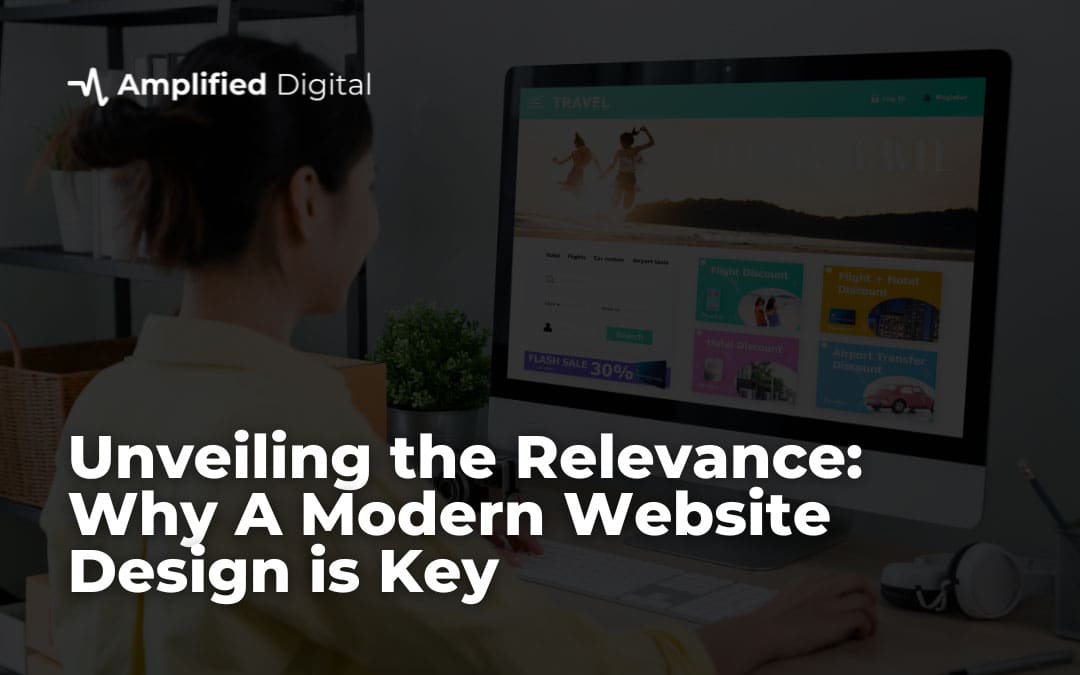In today’s rapidly evolving digital landscape, a website serves as the virtual storefront for small and large businesses alike. It’s not just a collection of web pages; it’s a dynamic platform that can make or break an online presence.
Despite this fact, many large businesses still do business with a website that is 10+ years old. Can you imagine not updating your storefront for that long? Not washing it, sweeping the front doorway, updating the signage? Not updating your website is the same thing, but only a lot more people will see it.
In this blog post, we will delve into the reasons why a website is not just a website but a crucial entity in the digital realm, and why you need a modern website to have the greatest success.
First Impressions Matter
In the digital era, first impressions are formed within seconds.
When comparing old websites to new ones, the impact of design and functionality becomes apparent. A new website, meticulously designed, creates a visually appealing and user-friendly experience. Its clean and intuitive interface establishes credibility, making visitors more likely to engage with the content and explore what the site has to offer.
In contrast, an older website might not embody the same level of aesthetic refinement or ease of use, potentially diminishing its credibility and reducing visitor engagement. Thus, the first impression can significantly influence whether a visitor decides to stay and interact or leave and search elsewhere.
Not only that, but if you site doesn’t load in just 2 seconds or less, a majority of visitors will bounce. That means less people even get to your site to get a first impression, because the very first impression is that your site doesn’t function well enough to load at a quick rate.
Validity of Business Information

Websites act as crucial information hubs, but the effectiveness of this function can be severely compromised by outdated design and neglect.
If a website appears old and neglected, it’s likely that visitors will question the accuracy of the information presented.
Even if the content is correct and up-to-date, the outdated aesthetics and disorganized structure can lead to perceptions of unreliability. Visitors might assume that because the website has not been maintained visually, the information it hosts might be equally outdated or incorrect.
This highlights the importance of regular updates and modern design to ensure that a website remains a trusted and efficient source for all relevant content, whether it’s about your business, services, or products.
Showcasing Your Expertise
For businesses and professionals, a website should be a canvas where you showcase your expertise. However, if the website is outdated, it may fail to effectively highlight your skills, achievements, and knowledge.
An old website might lack the modern features and design elements necessary to present a portfolio, case studies, or a blog in an engaging way. This not only diminishes the opportunity to attract potential clients or employees but also undermines your position as a thought leader in your industry.
A current, well-designed website is crucial for demonstrating your professional capabilities and for positioning yourself as an authoritative figure in your field.
An old, outdated website makes it hard for people to trust that you are serious about your business.
Accessibility and Convenience
Websites are expected to be accessible and convenient for all users, including those with disabilities.
Modern accessibility standards, such as the inclusion of alt tags for images, proper contrast ratios, and navigable design for screen readers, are critical for ensuring that everyone can use a website effectively.
However, outdated websites often fail to meet these new requirements.
Lacking these essential accessibility features can not only disenfranchise visitors with disabilities but could also expose the website owner to legal risks under laws designed to protect the rights of individuals with disabilities.
An old website, therefore, might not just inconvenience a visitor; it could potentially lead to significant compliance issues.
Updating a website to align with current accessibility standards is crucial not only for ethical reasons but also to avoid possible legal complications.
Engagement and Interaction
Websites facilitate direct engagement with your audience through interactive features such as contact forms, comments sections, or chat options. These tools enable two-way communication, fostering a sense of community and building trust.
However, outdated websites often lack these modern interactive capabilities or may feature versions that are no longer user-friendly by today’s standards. This can make visitors feel ignored rather than heard and valued, reducing their likelihood of converting into customers or loyal followers.
An old website that fails to engage effectively can deter interaction, diminishing the opportunity to build meaningful connections with your audience.
Updating interactive features is crucial for maintaining an active and engaging online presence.
Adaptability to Change

In the rapidly evolving digital landscape, the ability to update and adapt websites easily is crucial.
However, outdated websites often face significant challenges in this area. These older platforms may not be built to accommodate the latest technologies or design trends, making it difficult, if not impossible, to implement changes without extensive overhauls.
This rigidity can hinder a website’s ability to stay aligned with current standards and user expectations. In contrast, newer websites are designed with flexibility in mind, allowing for easier and more fluid updates and design changes.
This adaptability not only ensures that the site remains relevant but also makes it more responsive to user feedback and emerging trends.
Investing in modern website architecture is essential for maintaining an effective and contemporary online presence.
Marketing and Branding
A website is a critical tool for marketing and branding, serving as the digital face of your brand. Modern websites, enhanced with SEO strategies, social media integration, and strategic marketing techniques, become discoverable by a broader audience.
These elements help a website stand out in a crowded digital landscape, ensuring it captures the attention of potential customers and stakeholders. A well-branded, contemporary website leaves a lasting impression, significantly boosting brand awareness and recognition.
Conversely, an outdated website may fail to leverage new marketing practices and technologies, potentially diminishing its reach and impact.
Investing in a modern website design and keeping up with digital marketing trends are essential for a brand looking to maintain a strong and appealing online presence.
Let’s Bring Your Website Up-To-Date
In today’s digital era, having an updated, modern website is crucial for making a strong first impression, maintaining relevance, and enhancing user engagement.
An outdated website can hinder your ability to showcase expertise, adapt to changes, and effectively market and brand your business.
Amplified Digital Agency specializes in transforming old, neglected websites into vibrant, efficient, and responsive online entities. By rebuilding your site with us, you can ensure it meets modern accessibility standards, which not only enhances user experience but also prevents potential legal issues.
Our expertise in SEO, social media integration, and contemporary web design allows us to create a site that not only looks great, but works effectively to attract and retain a wider audience.
Let Amplified Digital Agency help you unlock the full potential of your digital presence, making your website a cornerstone of your digital success.
Contact us at Amplified Digital Agency to learn more about how we can elevate your website and brand.

